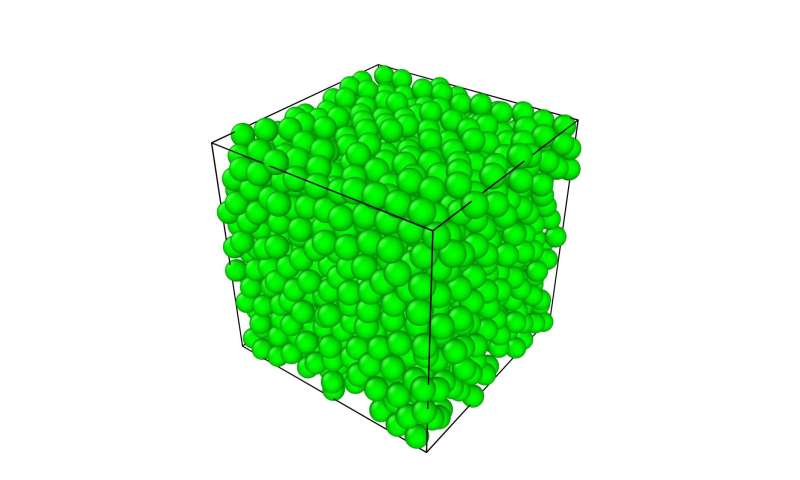An exact solution for the random close packing problem in 2D and 3D

Imagine placing oranges or tennis balls into a rigid container. How can the balls be arranged such that they occupy the largest volume fraction of the container, otherwise known as the largest packing density? This is one of the oldest problems in discrete geometry, which has many applications in physics, since atoms in condensed matter can be schematized like rigid balls to rationalize the atomic structure of solids and liquids. The answer to this problem will be different depending on whether the balls are arranged in a fully ordered way, thus each occupying a well-defined position in a crystalline lattice, or if they are instead randomly placed.
An old problem in mathematics
The great German mathematician David Hilbert, at the start of 20th century, inserted this problem in his famous list of unsolved fundamental problems in math (this is indeed part of Hilbert's 18th problem). The problem has, therefore, two "answers," depending on whether the spheres are arranged in an orderly way (like atoms in a crystal lattice) or in a completely random, disordered way. The first part of the problem got an answer when Kepler suggested that spheres arranged in a face-centered cubic lattice provide the densest packing possible in nature. Gauss, in the 19th century, calculated analytically the corresponding volume fraction (about 0.74), and more recently, the American mathematician Thomas Hales demonstrated in the 1990s via formal methods that in the ordered case, the Kepler conjecture is indeed verified rigorously.
The surprising power of analytical probability and statistics methods
However, when the balls are placed at random in a container, the calculation of the densest packing fraction is not trivial, as there is a huge number of random configurations in which the balls can be arranged. So far, only computers or experiments have been able to provide quantitative estimates of the occupied volume for each configuration. Previous mathematical approaches are mostly heuristic, in the sense that they rely on some particular geometric construction and assumptions (e.g., considering tetrahedra of particles as the main blocks of the packing or analyzing the voids in between the particles).
Now, this problem has been solved mathematically without the aid of a computer in a simple way—for the first time, in a purely statistical way. This was achieved by accounting for the statistical correlations between particles due to their mutual repulsion. This new solution is, to some extent, surprising. It is based on a simple statistical-probabilistic method used in the atomic theory of liquids to compute the probability to have a certain number of spheres within a given distance from a sphere at the center of the frame upon increasing the density of the spheres. No further assumptions are used besides the physically justified one about the impenetrability of the spheres.
Concluding remarks
For a long time, scientists believed that a statistical solution to this problem was impossible given the complexity of the many-body interactions among the many spheres that repel at contact. Instead, this solution has produced values in good agreement with experimental data in both 3D and 2D. Furthermore, the method opens up new avenues for our understanding of complex physical systems dominated by randomness, from the structure-property relation in liquids and glasses (e.g., how can we predict viscosity or rigidity of materials based on their random structure?) to randomness of both small-scale and large-scale structures in the universe. Finally, these new estimates of random close-packing in both 2D and 3D lie close to the upper limits of the values typically seen in experiments and simulations. It is to be ascertained in future work if these values do coincide with the densest arrangements that the packing can reach without having to "promote" local ordering of the spheres.
This story is part of Science X Dialog, where researchers can report findings from their published research articles. Visit this page for information about ScienceX Dialog and how to participate.
More information: Alessio Zaccone, Explicit Analytical Solution for Random Close Packing in d=2 and d=3, Physical Review Letters (2022). DOI: 10.1103/PhysRevLett.128.028002
Bio:
After receiving a PhD at ETH Zurich, Alessio Zaccone has been on the faculty of Technical University Munich, University of Cambridge, and University of Milan. In 2011 with his student E. Scossa-Romano, he analytically solved the elasticity problem of random sphere packings and elastic random networks. Later he developed an equation, with J. Krausser and K. Samwer, for the viscosity of liquids and a molecular-level theory of the glass transition based on thermoelasticity, the latter with E. Terentjev. With K. Trachenko, he discovered and mathematically predicted that the low-frequency shear modulus of liquids scales with the inverse cubic power of the (sub-millimeter) confinement length, a law that has been observed experimentally in many different systems. With M. Baggioli he developed a universal model for the vibrational density of states of solids and discovered topological defects in the displacement field of amorphous solids. More recently, with C. Setty and M. Baggioli, he has developed the anharmonic theory of phonon-mediated superconductivity, which extends the BCS theory to materials with anharmonicity, disorder and to high-pressure materials.